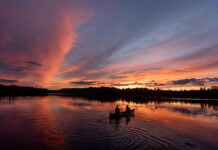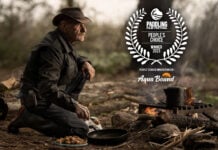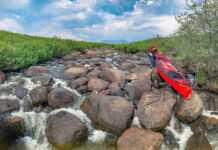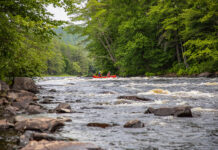It was evening when we discovered the hole in the canoe. The four of us stood in a huddle staring blankly at the inch-long gash. “How’d that happen?” someone asked.
It didn’t matter how it happened or what caused it, the damage needed to be fixed. It was only day 14 of a 90-day expedition that would trace the Yukon River from source to sea. We were traveling the third longest river in North America, exploring the origins of the Athapaskan First Nation people who walked from Asia across the Bering land bridge to settle here more than 10,000 years ago.
Already the romanticism of traveling 2,000 miles by paddle was beginning to wear as thin as the hulls of our well-loved boats.
The next morning on the banks of the Yukon River we fired up the satellite phone and called Patricia and Trevor, our friends in Whitehorse who were helping with logistics. If we could make it to Dawson City, two days away by paddle, they’d scrounge up a fiberglass repair kit. With a plan in place we carefully shoved off.
Dawson couldn’t come fast enough. We spent 48 hours battling the frigid downpours, pausing often to bail water entering the boat from above and below. It was late afternoon when we rounded the final bend and laid eyes on the historical Klondike city. Salvation.
For the first time in two days I didn’t wince when the canoe slid up on a sandy bank. We had arrived at the local Dawson campground. We unloaded the boats and found a covered area to stash the damaged canoe.
Patricia and Trevor arrived early in the morning. We wasted little time before getting down to business. It had rained all night and the river’s damp caress let nothing dry. The damaged area needed to be completely dry in order for the fiberglass patch to adhere. Without missing a beat, fellow paddler Ian Finch announced he had the solution and ran to retrieve his camp stove. Ian attached his propane canister and sparked the stove. Its flame filled the dreary shed with warm light.
For three minutes Ian applied heat to the damaged area of the hull. We then epoxied our fiberglass patch in place. The rest of the repair went smoothly. After a day and night of curing time the canoe that had carried us from the source of the Yukon River was now ready to continue its long journey to the Bering Sea.
Feature photo: Jay Kolsch









Okay, that is quite misleading. The camp stove was not used to make an emergency repair, it was used to prepare to make a repair. All this done off the water at a campground. They could have used a hair dryer. I was expecting to read how an emergency repair was done by melting a discarded plastic bottle or plastic rope with a camp stove (a repair that I have made to my kayak). Okay, you fooled me.
It had to be 30 years ago. I arrived at the campground expecting to race my fiberglass canoe only to find it had been used the day before and hit a rock causing a hole. No problem. When I got there Bud Findley was heating the resin and the canoe, one over the campfire and a campstove under the canoe. I raced thanks to Bud and the camp stove and campfire. (the metal camping cup had to; thrown away after the repair.
Still, although misleading someone took the time to share their story with us. For that, I’m thankful!
We snapped an outwale on the first day of a two week trip. We wrapped rope around the hull to keep its shape and paddled the rest of the day in rain. On the way we grabbed some wood from a beaver lodge and once camped, we ran the coleman stove under the canoe, with a tarp over it, to dry out the break. Unlike a lot of folks, we always bring a small FG repair kit with us and this allowed us to effect a repair with beaver lodge sticks carved to fit and glassed into place. All good to go in the morning and we used the canoe that way for another two years…lol.
Did they leave on a trip with out duct tape ? it could have kept them going for a while .